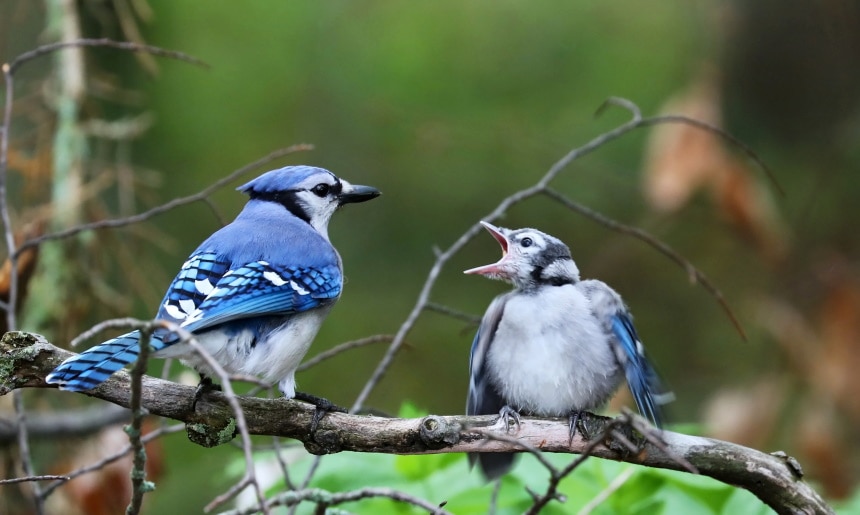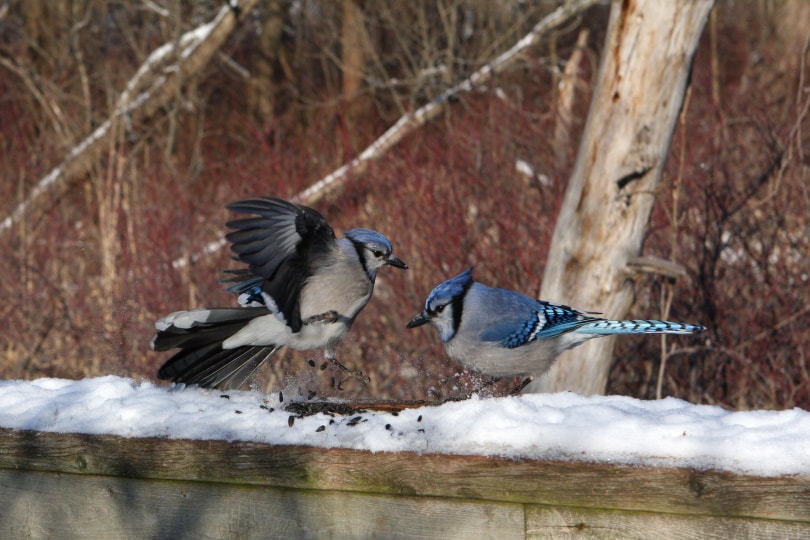Do Blue Jays Eat Other Birds? What do They Eat?
Last Updated on

Blue jays have developed a bad reputation for being overly aggressive, and some birdwatchers and casual observers consider them pariahs of the bird kingdom. They dive and squawk at humans who approach their nests and chase smaller birds away from the birdfeeders. Although they’re more territorial than other species, are blue jays capable of feasting on other species? Yes, blue jays are opportunistic creatures that can eat eggs and hatchlings, but the shocking behavior is not ordinary. They prefer eating meals that involve less risk.

The Typical Diet of Blue Jays
Blue jays are omnivorous, and they have a particular fondness for eating acorns. They seem to like variety in their meals, but 75% of their food each year comes from plants and vegetable matter. Since most of their diet is not meat-based, the birds’ reputation as murderers of infants is exaggerated. Some of the jay’s favorite snacks include:
- Grain
- Seeds
- Small fruit
- Berries
- Beechnuts
- Acorns
- Caterpillars
- Grasshoppers
- Beetles
- Spiders
- Snails
- Frogs
- Tiny rodents
- Carrion
The jay’s durable bill allows it to enjoy hard nuts that other species are incapable of piercing. After finding nuts or seeds, the bird uses its beak like a jackhammer to open the hard shell. Blue jays prefer eating caterpillars instead of insects, reptiles, or rodents, but they’re not opposed to feeding on dead animals when food is scarce. Blue Jays may decide to raid another bird’s nest when it’s desperate, but they’re not the only bird that dines on hatchlings and eggs.

Other Birds That Feast on Hatchlings and Eggs
Blue jays are one of the largest songbirds, and their size, aggression, and threatening beaks allow them to bully smaller songbirds. However, larger species, including birds of prey, are more likely to feast on baby birds than blue jays. Owls, hawks, and falcons dine on various mammals, reptiles, and fish, but they’re also bird eaters. Predatory birds are known for eating eggs and hatchlings, but you may be surprised by some of the other species that enjoy avian meat in their diet.
- American Crow: Blue jays chase away small birds from a feeder, but they retreat when they see a crow. The crow will attack a blue jay when it hogs the feeder, but they are also notorious for raiding nests for eggs and nestlings. Their favorite species to eat include blue jays, loons, sparrows, robins, eiders, and terns.
- American Raven: Ravens sometimes dine on nestling blue herons and rock pigeons, but they also eat carrion, insects, fruit, and grain.
- Black-Crowned Night Heron: Adult herons sometimes feast on the eggs of nearby nests, and juveniles will eat their brother or sister if it falls out of the nest prematurely and is injured or killed.
- Gray jay: In arboreal forests, gray jays often raid other birds’ nests for eggs. They also eat fungi, carrion, insects, and berries.
- Great Black-Backed Gull: The great black-backed gulls sometimes form mating pairs that primarily focus on killing and eating herring gull chicks. They also hunt roseate terns, common murres, Atlantic puffins, horned grebes, and manx shearwaters.
- Great Blue Heron: This prehistoric-looking creature eats birds, amphibians, crustaceans, fish, and insects.
- Northern Shrike: Shrikes eat insects, mammals, and small birds. They have a gruesome habit of dropping their victims on barbed-wire fences or spiked plants to impale them.
- Red-Bellied Woodpecker: The woodpecker enjoys tormenting and chasing blue jays away from feeders, and it dines on spiders, insects, minnows, nestlings, and lizards.
- Red-Headed Woodpecker: Although the red-headed woodpecker eats nuts, seeds, and berries, it also dines on eggs, nestlings, adult birds, and mice.

Mating Habits and Protective Nature of Blue Jays
Blue jays engage in a spirited aerial chase during the mating ritual, and males try to impress their partners by feeding them. Jays mate for life, and as parents, they’re fierce guardians of their family. After their eggs hatch, the parents share the feeding responsibilities.
Most birds are irritated when humans or other animals walk near a nest, but blue jays are not subtle about their warnings. They shriek, with their crests pointing upwards, and swoop down to attack if the invader fails to back off. Since several larger birds like hawks and owls prey on blue jays, they live in small flocks to protect their nests and territory. If they cannot handle an attacker, they form large mobs to force the predator away.
Migration
Although blue jay migrations have been tracked for several years, the reasons for the birds’ movements remain a mystery. Younger jays seem more willing to migrate than adults, but several adults also make long journeys to find new homes. Although most species move to warmer climates when migrating, blue jays do not seem to follow the same logic. Some birds will fly north to spend the winter and then fly south the following winter.

Vocalizations
Blue jays are vocal creatures that fill backyards with melodies, warn other birds of predators, and mimic other species. Although the theory is unproven, some have speculated that blue jays imitate other predatory birds when approaching a bird feeder to scare off the competition. Some of the jay’s best impersonations include Cooper’s hawks, red-tailed hawks, and red-shouldered hawks.
Physical Characteristics
The striking blue plumage of the blue jay is not a color that typically appears in nature. The bird only has the brown pigment melanin, but specialized cells on the feathers refract the light and make it appear blue. Damaged or crushed feathers lose their blue tint.
If you observe a blue jay from a safe distance, you can watch the crest on its head for signs of its mood. When the bird eats with other family members, it’s relaxed with its crest flattened against its head. The crest points upwards when it sees another bird or animal approaching the nest. Unlike other species, the male and female jays look almost identical. Even experienced bird watchers have problems identifying the sex without examining them close up.
Related Read: Do Birds Eat Ants? What You Need To Know!
Backyard Bird Feeding Tips
Some birdwatchers believe blue jays spoil their fun by chasing away other colorful songbirds. If the jays dominate your backyard feeders, you can minimize the problems with other birds with these tips.
- Set up feeders specifically for blue jays near bushes or small trees. They prefer large feeders on posts instead of hanging feeders.
- Add peanuts, cracked corn, or dried mealworms to the blue jay-only feeders.
- Add nyjer (thistle) seed to the other feeders. Blue jays dislike the seed and may stop bothering other birds who enjoy it.
- Space your feeders far apart to minimize conflicts.


Conclusion
The blue jay has been called the “backyard bully,” and it’s not opposed to feasting on other species’ eggs or hatchlings. However, other birds are not usually on the blue jay’s menu, and consuming another bird is rare. Jays would rather eat insects, fruit, seeds, and nuts. They’re territorial and protective parents who seldom allow weaker birds to hog the treats in bird feeders. The survival of the jays’ family is their only concern, and although they appear aggressive, they’re only trying to discourage the competition from depleting their families’ food sources.
Featured Image Credit: Karel Bock, Shutterstock
About the Author Robert Sparks
Robert’s obsession with all things optical started early in life, when his optician father would bring home prototypes for Robert to play with. Nowadays, Robert is dedicated to helping others find the right optics for their needs. His hobbies include astronomy, astrophysics, and model building. Originally from Newark, NJ, he resides in Santa Fe, New Mexico, where the nighttime skies are filled with glittering stars.
Related Articles:
What Is the Best Binocular Magnification for Hunting? Optical Features Explained
10 Types of Hummingbirds in Arkansas (With Pictures)
8 Types of Hummingbirds in Nebraska (With Pictures)
5 Types of Hummingbirds in Idaho (With Pictures)
3 Types of Hummingbirds in Mississippi (With Pictures)
8 Types of Hummingbirds in Kansas (With Pictures)
5 Types of Hummingbirds in West Virginia (With Pictures)
5 Types of Hummingbirds in Ohio (With Pictures)
